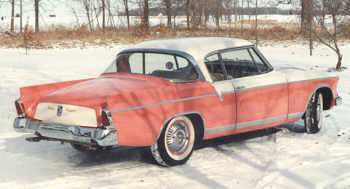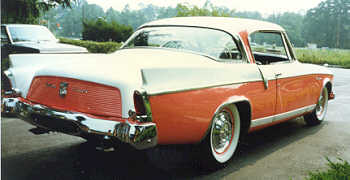Type I
Type III


The parts manual indicates that the new tri-level paint scheme began with body # 469. I keep wanting to equate body # 469 with serial # 6030469, as I did in issue #020, but this is not the case.
Bodies were not assigned to serial numbers in sequence. The only way to determine at what point the original style paint scheme ceased would be to examine the production orders.
Thanks to Dennis Lambert and Newman & Altman, I did just
that and the results proved quite interesting.
|
Type I |
Type III |
 |
 |
I want to stress that all the material which follows is based on the information recorded on the production orders. I have found some errors on these documents but, as was the case with the wheelcover article, they are the only records available.
The last South Bend car with the original style paint scheme was serial # 6030952 which was fitted to body # 245. This car was painted P5641 Ceramic Green/Snowcap White and had a final assembly date of 12-21-55.
The last Los Angeles 1956 Golden Hawk painted in the original paint scheme was serial # 6800242 with body # 408. This car was painted P5635 Snowcap White/Sunglow Gold and had a final assembly date of 12-29-55.
The picture is more clear if we look at the last five serial numbers
to have the original paint scheme:
| SERIAL # | BODY # | DATE | SERIAL # | BODY # | DATE | |
| 6030321 | 460 | 11-21-55 | 6800237 | 402 | 12-28-55 | |
| 6030336 | 419 | 11-22-55 | 6800238 | 406 | 12-28-55 | |
| 6030350 | 421 | 11-22-55 | 6800239 | 407 | 12-28-55 | |
| 6030751 | 103 | 12-12-55 | 6800240 | 403 | 12-28-55 | |
| 6030952 | 245 | 12-21-55 | 6800242 | 408 | 12-29-55 |
Notice that there was quite a gap between the last 3 South Bend cars while 6800241 is missing from the Los Angeles list.
The first South Bend 1956 Golden Hawk to be painted in the new tri-level paint scheme was serial # 6030289 fitted with body number 470. This car had a final assembly date of 11/19/55, and was painted P5620 Airforce Blue/Daybreak Blue.
The first Los Angeles assembled 1956 Golden Hawk with the new tri-level paint scheme was serial # 6800188 fitted with body number 599. This car was painted P5638 Mocha/Snowcap White with a final assembly date of 12-14-55.
Looking at the first five serial numbers to have the new tri-level paint
scheme, we have:
| SERIAL # | BODY # | DATE | SERIAL # | BODY # | DATE | |
| 6030289 | 470 | 11-19-55 | 6800188 | 599 | 12-14-55 | |
| 6030290 | 473 | 11-19-55 | 6800189 | 593 | 12-14-55 | |
| 6030294 | 476 | 11-21-55 | 6800190 | 596 | 12-14-55 | |
| 6030296 | 469 | 11-21-55 | 6800241 | 1206 | 12-29-55 | |
| 6030297 | 472 | 11-21-55 | 6800243 | 567 | 12-29-55 |
As stated earlier, the body numbers were not assigned in sequence so it can be a little confusing. The previously mentioned serial # 6800241 shows up in this list with body # 1206. Some cars with higher serial numbers have the original paint scheme, while some with lower serial numbers have the later tri-level paint scheme.
One item I found interesting was that serial numbers 6030002 through 6030026 did not have a body number listed. Instead of a paint code, the word "omit" was printed on the production order for each car. All 24 cars were exported to Brussels, Belgium.
Evidently those cars were painted at their destination. The paint scheme used on those 24 cars is anyone's guess. I thought that because those cars had no body numbers, I would find many missing body numbers in the 1-468 range. A more thorough examination proved that this was not the case. A check of all the body numbers in the range of 1 - 468, revealed that only body numbers 85, 106, 170, 223, and 300 were missing. It is doubtful that the 24 cars exported to Belgium would have had body numbers higher than 468 since they were among the first 26 cars produced.
I decided that I would try to see if I could find any clues that might help me locate these 5 missing body numbers and thus determine which serial number might be assigned.
The first clue came when I discovered that both serial # 6030058 and 6030059 were listed with body # 107. Body # 106 was not listed for any serial number. It is most likely that one of the above serial numbers (6030058 or 6030059) was built with body # 106.
The second clue involved body # 170. The production order for serial # 6800118 did not show a body number. In looking over the list, I noticed that serial #s 6800114 through 6800117 were assigned body #s 166 - 169. Serial #s 6800119 through 6800121 were assigned body # 171 - 173. It seems almost certain that serial # 6800118 was assigned to body # 170. Unfortunately, none of these serial numbers is registered in our group, so we will probably never know the real story.
Finally, serial #s 6030104 and 6800038 both showed body # 22 on their production orders. Upon closer examination, I noticed that for serial 6030104, the body # 22 was followed by a funny inverted arc which looks very much like this . Since body # 223 was missing, I decided that 6030104 probably had body # 223. The inverted arc was probably the bottom part of a 3. In many instances, a series of body numbers (not necessarily in sequence) ran within a range of serial numbers. Serial 6030110 had body # 222 and 6030099 had body # 224 so this fits in the general range.
If all the above is correct, this leaves only body #s 85, and 300 unaccounted for. Since I was unable to look at every production order, either or both of these body numbers may appear on a serial number beyond the area I was able to check.
I'm not familiar with the production process used by Studebaker. I suppose a few bodies could have been built, painted, and stored in a corner somewhere. As a particular colored body was needed, one could have been snatched from the pile and mounted on the appropriate serial number. Does anyone know the procedure?
Due to the random assignment of body numbers, the paint scheme change cannot be tied to any particular serial number. For the period of 10-28-55 through 12-21-55 in South Bend, and 12-14-55 through 12-29-55 in Los Angeles, both paint schemes were being used. The body number remains the only way to tell which paint scheme was used on any given car. Body # 1-468 were painted the original paint scheme while body numbers 469 through the end were painted the tri-level scheme.